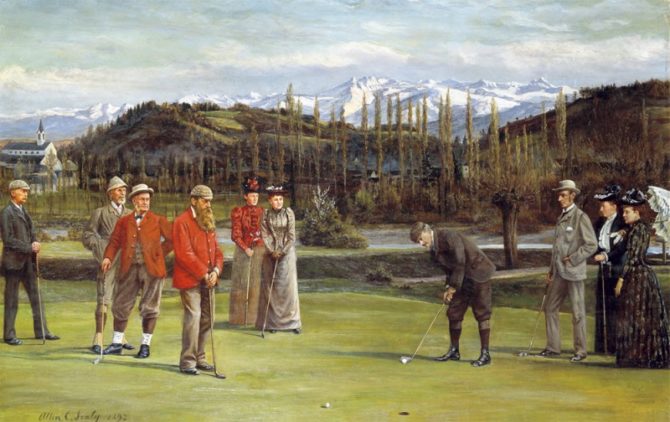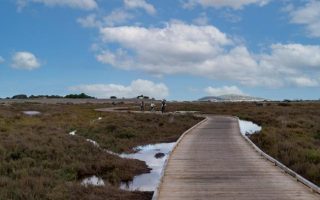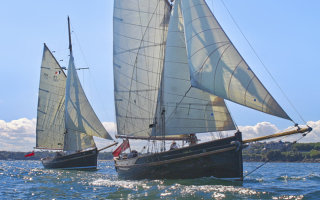Golf à la Basquaise

France does not readily spring to mind as one of the premier golfing nations. Who remembers Arnaud Massy, the former sardine fisherman from Biarritz who back in 1907 became the only Frenchman to win the British Open? And who can forget his fellow countryman Jean Van de Velde’s disastrous performance in the same event at Carnoustie, Scotland, in 1999 when he snatched defeat from the jaws of victory with a famous final-hole triple bogey?
Yet France does boast a proud golfing tradition. In 1856, continental Europe’s first golf course was created at the town of Pau in the sleepy Béarn region of the southwest—predating England’s first course, the Royal North Devon, by eight years. Admittedly the Pau course’s founders were British—after the Napoleonic wars Pau became a fashionable spa resort for the Victorians and it’s still known locally as the English town. But golf caught on with local residents too, and soon they were building their own courses on which to flail away at featheries with their mashie niblicks, cleeks and other strange Anglo-Scots golfing implements.
The Béarn, however, would not become the cradle of French golf despite Pau’s precocity. For that distinction, destiny chose the neighboring Basque region, where France, Spain and the Atlantic Ocean come together and the Pyrenees supply a dramatic backdrop. Destiny’s unlikely agent was Victor Hugo, although it’s doubtful that the great French novelist ever swung a golf club in his life. But he wielded a powerful pen and used it to great effect in the summer of 1843 when he sojourned in the Basque country while writing his Voyage aux Pyrénées. Until then the region’s main claim to fame and wider recognition was the ham named for the Basque cultural capital, Bayonne, and that somewhat more lethal export from the same city—the bayonet.
But Hugo’s pen put the Basque country firmly on the map and this “blessed land” as he described it soon became a major tourist destination. People flocked to the Basque coast with its wind- and wave-swept beaches and when, in the summer of 1854, the Emperor Napoleon III and his Empress Eugénie decided to make the former fishing port of Biarritz their preferred summer resort, there was no looking back. Other European crowned heads, including Queen Victoria and Alfonso XIII of Spain, followed and in their glittering wake came the cream of European society all eager to enjoy the invigorating ocean waters of the Bay of Biscay. Biarritz boasted that its “queen of beaches” had become a “beach for kings”.
As one of Europe’s most fashionable holiday destinations, the Basque coast underwent a rapid transformation. Palaces, pleasure domes and promenades were built, and bathing contraptions wheeled onto the beaches to satisfy the fashionable desire for therapeutic sea bathing while properly preserving one’s modesty. And, needless to say, golf courses were carved out of the surrounding countryside, mainly for British visitors who could not get enough of the region—the balmy local climate makes it particularly congenial as a winter resort as well as a summer destination.
In 1888, the first course to be built in the golf boom—and the second course to be built in France after Pau—was funded by the British Club in Biarritz and was called simply Le Phare after the nearby lighthouse. Today the Basque country boasts dozens of courses, making it one of Europe’s major golfing destinations with courses open all year round thanks to the clement climate. Here are five favorite courses I thoroughly recommend:
Le Phare
Designed by pioneering British golf course architects Tom and Willie Dunn (Willie went on to design an early course at the legendary Shinnecock Hills on Long Island), Le Phare began life as a semi-links course with several holes reaching down to the shoreline and plenty of sand around the fairways. Over the years it has evolved into more of a parkland course, but links skills are still needed when the wind comes whistling off the Bay of Biscay. Le Phare looks easier than it is and the greens can be lightning fast. As Biarritz has expanded it has encircled the club, which now occupies a plateau above the city. But with wonderful views out to sea and vast amounts of land—making this one of France’s prime pieces of real estate—the club has an exceptionally spacious feel. It may not have azaleas to compete with Georgia’s Augusta National, with which it is twinned, but Le Phare shares Augusta’s established air; it knows it has history and tradition on its side. Host since 1898 to the world’s oldest amateur golf competition, the Biarritz Cup, Le Phare is a great place to start any golfing visit to the Basque region. Besides, it is one of the clubs that participates in Golf Pass Biarritz—a brilliant arrangement whereby, even in high season (July 5 to August 31, 2010), the trifling sum of €300 allows you to play a round at five out of six great local courses, with one extra round at any of the five thrown in for the price (check out www.golfpassbiarritz.com). Low season tariff is €240.
2 ave Edith Cavell, Biarritz, 05.59.03.71.80. website
Golf d’Hossegor
About 20 miles up the coast from Biarritz lies the township of Hossegor, fringed with vast Atlantic beaches. Thanks to the magnificent ocean waves that roll in from the Bay of Biscay this area has become Europe’s surfing capital and Hossegor and neighboring Capbreton are host to a number of major events on the professional surfing circuit. But long before the surfers arrived in search of the perfect pipeline, golfers were heading to Hossegor for the golf. A wonderful parkland course with magnificent pine and oak trees lining the fairways, Hossegor has a very British atmosphere—explained at least in part by the fact that English architect John Morrison built the course in 1930. The last few years have seen some changes devised by American designer Cabell B. Robinson to, he says, “render the course less penal”. But it remains a challenging course, and a classic.
Unlike their counterparts in many parts of the world, French golf clubs have a well-deserved reputation for running good restaurants and many people who never play golf will go to their local golf club just for lunch. Hossegor is no exception. A small hotel attached to the club and run by the restaurant provides rooms at very reasonable rates.
For legal reasons best understood by the French and not easily explained in brief, Hossegor, as a private club, is not allowed to participate in the Golf Pass Biarritz program, but don’t let that deter you from playing there.
333 ave du Golf, Hossegor, 05.58.43.56.99. website
Chantaco
Founded by the Thion de la Chaume family, the in-laws of tennis champion René Lacoste, and designed by Harry Shapland Colt in 1928, Chantaco is one of the grand old dames of Basque golf, situated between the seriously cool resort port of Saint-Jean-de-Luz and the foothills of the Pyrenees. The mountain views are spectacular, and the mountain air helps to keep the course deliciously cool even on the hottest summer’s day. The 18-hole course itself is pretty impressive too, particularly the difficult, par 4 fifth hole. Chantaco went through a period of neglect, notably during World War II, but it has been brought back to its original high standard in recent years, reopening in 2002 with a renovated course. Today Chantaco is effectively two courses in one: the front nine carved into wooded hills; the back nine flatter, with more water. It features on most lists of France’s top courses and has hosted the French Open. Be prepared for a challenge.
A bonus: Chantaco lies at the foot of the Pyrenees peak known as La Rhune, whose summit can be reached by a small railway that operates daily during the summer season. You may not be able to see your lost ball from up there but the panoramic views of the Basque region are well worth the detour.
Route d’Ascain, Saint-Jean-de-Luz, 05.59.26.14.22. website
Golf de La Nivelle
When Edward Prince of Wales and his mistress Wallis Simpson headed to Biarritz each year for the summer, the battle cry was: “Chill the champagne, pack the pearls and tune up the Bugatti.” The king-in-waiting, who would later be crowned Edward VIII and then, after his abdication, demoted to Duke of Windsor, might also have added “throw in the golf clubs”. A keen golfer, Edward knew exactly where he liked to play—the Golf de La Nivelle in the small village of Ciboure just across the Adour River from Saint-Jean-de-Luz.
By the time the Prince of Wales visited in the 1930s, it was already a well-established course, having opened its doors in 1907. The course has great views of the ocean and the mountains, but you’ll want to pay close attention to the tight fairways and tiny greens if you want to card a decent score. When he was in town, Prince Edward played there every day, and followed his game with afternoon tea at La Réserve hotel, perched on a nearby cliff overlooking the ocean. The tearoom survives, so you can do that after your game too.
Place William Sharp, Ciboure, 05.59.47.18.99. website
Golf de Chiberta, Anglet
These days Anglet is really a suburb of both Biarritz and Bayonne, nestled beneath the estuary of the Adour River and the beaches that stretch down to the Biarritz seafront itself. Called the Plages de la Chambre d’Amour, the Anglet beaches are named after a nearby grotto, where legend has it that an unlucky pair of young lovers drowned when they were surprised by a swift-rising storm-driven tide.
Although the Basque coastline boasts beaches and dunes galore, Chiberta is one of the few regional courses that gets close to being a true links course (seaside, sandy soil, natural terrain) when it heads down to the ocean shore after meandering for a while through pine trees. It was designed and completed back in 1927 by the legendary amateur golf architect Tom Simpson, who was asked by the Prince of Wales to create “the best course in Europe”. The original layout remains largely intact so you can judge for yourself whether it represents mission accomplished. Simpson believed that golf should be “a game of real adventure” in which “mental agility” was more important than brute strength and Chiberta remains true to those beliefs. Its proximity to the ocean is both a bane and a blessing: mild winters keep this club open year-round, but sudden storms can make it virtually unplayable at times. At least when that happens, you can retire to the clubhouse for a glass of Irouléguy, the Basque Country’s renowned red wine.
In addition to the 18-hole links course, Chiberta has a less-demanding nine-hole course, the Golf de l’Impératrice. A hotel attached to the club boasts three stars but gets mixed reviews.
104 blvd des Plages, Anglet, 05.59.52.51.10. website
Originally published in the October 2009 issue of France Today; updated October 2010
Share to: Facebook Twitter LinkedIn Email
Leave a reply
Your email address will not be published. Required fields are marked *



